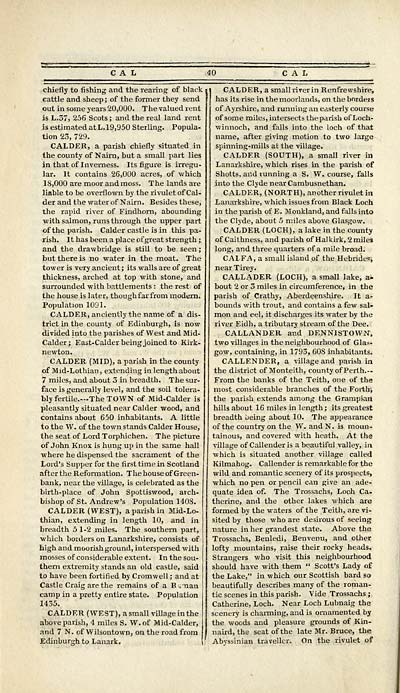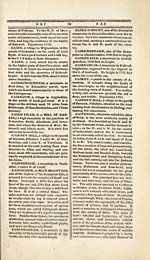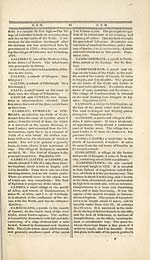Gazetteer of Scotland
(42) Page 40
Download files
Complete book:
Individual page:
Thumbnail gallery: Grid view | List view

C A L
chiefly to fishing and the rearing of black
cattle and sheep ; of the former they send
out in some years 20,000. The valued rent
is L.37, 256 Scots ; and the real land rent
is estimated atL.19,950 Sterling. Popula-
tion 23, 729.
CALDER, a parish chiefly situated in
the county of Nairn, but a small part lies
in that of Inverness. Its figure is irregu-
lar. It contains 26,000 acres, of which
18,000 are moor and moss. The lands are
liable to be overflown by the rivulet of Cal-
der and the water of Nairn. Besides these,
the rapid river of Findhorn, abounding
with salmon, runs through the upper part
of the parish. Calder castle is in this pa-
rish. It has been a place of great strength ;
and the drawbridge is still to be seen ;
but there is no water in the moat. The
tower is very ancient ; its walls are of great
thickness, arched at top with stone, and
surrounded with battlements : the rest of
the house is later, though far from modern.
Population 1091.
CALDER, anciently the name of a dis-
trict in the county of Edinburgh, is now
divided into the parishes of West and Mid-
Calder; East-Calder being joined to Kirk-
newton.
CALDER (MID), a parish in the county
of Mid-Lothian, extending in length about
7 miles, and about 5 in breadth. The sur-
face is generally level, and the soil tolera-
bly fertile.—The TOWN of Mid-Calder is
pleasantly situated near Calder wood, and
contains about 650 inhabitants. A little
to the W. of the town stands Calder House,
the seat of Lord Torphichen. The picture
of John Knox is hung up in the same hall
where he dispensed the sacrament of the
Lord's Supper for the first time in Scotland
after the Reformation. The house of Green-
bank, near the village, is celebrated as the
birth-place of John Spottiswood, arch-
bishop of St. Andrew's Population 140S.
CALDER (WEST), a parish in Mid-Lo-
thian, extending in length 10, and in
breadth 51-2 miles. The southern part,
which borders on Lanarkshire, consists of
high and moorish ground, interspersed with
mosses of considerable extent. In the sou-
thern extremity stands an old castle, said
to have been fortified by Cromwell ; and at
Castle Craig arc the remains of a R .nan
camp in a pretty entire state. Population
1435.
CALDER (WEST), a small village in the
above parish, 4 miles S. W. of Mid-Calder,
and 7 N. of Wilsontown, on the road from
Edinburgh to Lanark.
40
C A L
CALDER, a small river in Renfrewshire,
has its rise in the moorlands, on the borders
of Ayrshire, and running an easterly course
of some miles, intersects the parish of Loch-
winnoch, and falls into the loch of that
name, after giving motion to two large
spinning-mills at the village.
CALDER (SOUTH), a small river in
Lanarkshire, which rises in the parish of
Shotts, and running a S. W. course, falls
into the Clyde nearCambusnethan.
CALDER, (NORTH), another rivulet in
Lanarkshire, which issues from Black Loch
in the parish of E. Monkland, and falls into
the Clyde, about 5 miles above Glasgow.
CALDER (LOCH), a lake in the county
of Caithness, and parish of Halkirk, 2 miles
long, and three quarters of a mile broad.
CAIFA, a small island of the Hebrides;
near Tirey.
CALLADER (LOCH), a small lake, a.
bout 2 or 3 miles in circumference, in the
parish of Crathy, Aberdeenshire. It a-
bounds with trout, and contains a few sal-
mon and eel, it discharges its water by the
river Eidh, a tributary stream of the Dee.
CALLANDER and DENN1STOWN,
two villages in the neighbourhood of Glas-
gow, containing, in 1793, 60S inhabitants.
CALLENDER, a village and parish in
the district of Monteith, county of Perth.—
From the banks of the Teith, one of the
most considerable branches of the Forth-,
the parish extends among the Grampian
hills about 16 miles in length ; its greatest
breadth ueing about 10. The appearance
of the country on the W. andN. is moun-
tainous, and covered with heath. At the
village of Callenderis a beautiful valley, in
which is situated another village called
Kilmahog. Callender is remarkable for the
wild and romantic scenery of its prospects,
which no pen or pencil can give an ade-
quate idea of. The Trossachs, Loch Ca.
therine, and the other lakes which are
formed by the waters of the Teith, are vi-
sited by those who are desirous of seeing
nature in her grandest state. Above the
Trossachs, Benledi, Benvenu, and other
lofty mountains, raise their rocky heads.
Strangers who visit this neighbourhood
should have with them " Scott's Lady of
the Lake," in which our Scottish bard so
beautifully describes many of the roman-
tic scenes in this parish. Vide Trossachs ;
Catherine, Loch. Near Loch Lubnaig the
scenery is charming, and is ornamented by
the woods and pleasure grounds of Kin-
naird, the seat of the late Mr. Bruce, the
Abyssinian traveller. On the rivulet of
chiefly to fishing and the rearing of black
cattle and sheep ; of the former they send
out in some years 20,000. The valued rent
is L.37, 256 Scots ; and the real land rent
is estimated atL.19,950 Sterling. Popula-
tion 23, 729.
CALDER, a parish chiefly situated in
the county of Nairn, but a small part lies
in that of Inverness. Its figure is irregu-
lar. It contains 26,000 acres, of which
18,000 are moor and moss. The lands are
liable to be overflown by the rivulet of Cal-
der and the water of Nairn. Besides these,
the rapid river of Findhorn, abounding
with salmon, runs through the upper part
of the parish. Calder castle is in this pa-
rish. It has been a place of great strength ;
and the drawbridge is still to be seen ;
but there is no water in the moat. The
tower is very ancient ; its walls are of great
thickness, arched at top with stone, and
surrounded with battlements : the rest of
the house is later, though far from modern.
Population 1091.
CALDER, anciently the name of a dis-
trict in the county of Edinburgh, is now
divided into the parishes of West and Mid-
Calder; East-Calder being joined to Kirk-
newton.
CALDER (MID), a parish in the county
of Mid-Lothian, extending in length about
7 miles, and about 5 in breadth. The sur-
face is generally level, and the soil tolera-
bly fertile.—The TOWN of Mid-Calder is
pleasantly situated near Calder wood, and
contains about 650 inhabitants. A little
to the W. of the town stands Calder House,
the seat of Lord Torphichen. The picture
of John Knox is hung up in the same hall
where he dispensed the sacrament of the
Lord's Supper for the first time in Scotland
after the Reformation. The house of Green-
bank, near the village, is celebrated as the
birth-place of John Spottiswood, arch-
bishop of St. Andrew's Population 140S.
CALDER (WEST), a parish in Mid-Lo-
thian, extending in length 10, and in
breadth 51-2 miles. The southern part,
which borders on Lanarkshire, consists of
high and moorish ground, interspersed with
mosses of considerable extent. In the sou-
thern extremity stands an old castle, said
to have been fortified by Cromwell ; and at
Castle Craig arc the remains of a R .nan
camp in a pretty entire state. Population
1435.
CALDER (WEST), a small village in the
above parish, 4 miles S. W. of Mid-Calder,
and 7 N. of Wilsontown, on the road from
Edinburgh to Lanark.
40
C A L
CALDER, a small river in Renfrewshire,
has its rise in the moorlands, on the borders
of Ayrshire, and running an easterly course
of some miles, intersects the parish of Loch-
winnoch, and falls into the loch of that
name, after giving motion to two large
spinning-mills at the village.
CALDER (SOUTH), a small river in
Lanarkshire, which rises in the parish of
Shotts, and running a S. W. course, falls
into the Clyde nearCambusnethan.
CALDER, (NORTH), another rivulet in
Lanarkshire, which issues from Black Loch
in the parish of E. Monkland, and falls into
the Clyde, about 5 miles above Glasgow.
CALDER (LOCH), a lake in the county
of Caithness, and parish of Halkirk, 2 miles
long, and three quarters of a mile broad.
CAIFA, a small island of the Hebrides;
near Tirey.
CALLADER (LOCH), a small lake, a.
bout 2 or 3 miles in circumference, in the
parish of Crathy, Aberdeenshire. It a-
bounds with trout, and contains a few sal-
mon and eel, it discharges its water by the
river Eidh, a tributary stream of the Dee.
CALLANDER and DENN1STOWN,
two villages in the neighbourhood of Glas-
gow, containing, in 1793, 60S inhabitants.
CALLENDER, a village and parish in
the district of Monteith, county of Perth.—
From the banks of the Teith, one of the
most considerable branches of the Forth-,
the parish extends among the Grampian
hills about 16 miles in length ; its greatest
breadth ueing about 10. The appearance
of the country on the W. andN. is moun-
tainous, and covered with heath. At the
village of Callenderis a beautiful valley, in
which is situated another village called
Kilmahog. Callender is remarkable for the
wild and romantic scenery of its prospects,
which no pen or pencil can give an ade-
quate idea of. The Trossachs, Loch Ca.
therine, and the other lakes which are
formed by the waters of the Teith, are vi-
sited by those who are desirous of seeing
nature in her grandest state. Above the
Trossachs, Benledi, Benvenu, and other
lofty mountains, raise their rocky heads.
Strangers who visit this neighbourhood
should have with them " Scott's Lady of
the Lake," in which our Scottish bard so
beautifully describes many of the roman-
tic scenes in this parish. Vide Trossachs ;
Catherine, Loch. Near Loch Lubnaig the
scenery is charming, and is ornamented by
the woods and pleasure grounds of Kin-
naird, the seat of the late Mr. Bruce, the
Abyssinian traveller. On the rivulet of
Set display mode to: Large image | Transcription
Images and transcriptions on this page, including medium image downloads, may be used under the Creative Commons Attribution 4.0 International Licence unless otherwise stated. ![]()
| Gazetteers of Scotland, 1803-1901 > Gazetteer of Scotland > (42) Page 40 |
|---|
| Permanent URL | https://digital.nls.uk/97422198 |
|---|

